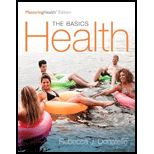
Health: The Basics, The Mastering Health Edition (12th Edition)
12th Edition
ISBN: 9780134183268
Author: Rebecca J. Donatelle
Publisher: PEARSON
expand_more
expand_more
format_list_bulleted
Question
Chapter 1, Problem 6PQ
Summary Introduction
To determine: The suggestion from socially cognitive behavior model.
Introduction:
Behavior change is the modification in the behavior pattern. It is an event or a process that substitutes itself with newer or better ones. This takes long time and more stages to be accomplished.
Social cognitive model is related to reciprocal fashion that promotes and stimulates change through thoughts and behaviors.
Expert Solution & Answer
Want to see the full answer?
Check out a sample textbook solution
Chapter 1 Solutions
Health: The Basics, The Mastering Health Edition (12th Edition)
Ch. 1 - Prob. 1WDYTCh. 1 - Prob. 2WDYTCh. 1 - Prob. 3WDYTCh. 1 - Prob. 4WDYTCh. 1 - Prob. 5WDYTCh. 1 - Prob. 6WDYTCh. 1 - Prob. 7WDYTCh. 1 - Prob. 8WDYTCh. 1 - Prob. 9WDYTCh. 1 - Prob. 1PQ
Ch. 1 - What statistic is used to describe the number of...Ch. 1 - Prob. 3PQCh. 1 - Janice describes herself as confident and...Ch. 1 - Healthy People 2020 is a(n) a. blueprint for...Ch. 1 - Prob. 6PQCh. 1 - Suppose you want to lose 20 pounds. To reach your...Ch. 1 - Prob. 8PQCh. 1 - Prob. 9PQCh. 1 - Prob. 10PQCh. 1 - Prob. 1TAICh. 1 - Prob. 2TAICh. 1 - What are some of the health disparities that exist...Ch. 1 - Prob. 4TAICh. 1 - Prob. 5TAICh. 1 - Prob. 1PQACh. 1 - Prob. 2PQACh. 1 - Prob. 3PQA
Knowledge Booster
Similar questions
- Explore values pertaining to end-of-life decisionsarrow_forwardIn small groups, explore the following questions: To what degree might your personal needs get in the way of your work with clients? How can you recognize and meet your needs without having them interfere with your work with others?arrow_forwardHow would you judge the accuracy or validity of complementary and alternative medicine practices?arrow_forward
Recommended textbooks for you
 Comprehensive Medical Assisting: Administrative a...NursingISBN:9781305964792Author:Wilburta Q. Lindh, Carol D. Tamparo, Barbara M. Dahl, Julie Morris, Cindy CorreaPublisher:Cengage Learning
Comprehensive Medical Assisting: Administrative a...NursingISBN:9781305964792Author:Wilburta Q. Lindh, Carol D. Tamparo, Barbara M. Dahl, Julie Morris, Cindy CorreaPublisher:Cengage Learning- Lifetime Physical Fitness & WellnessHealth & NutritionISBN:9781337677509Author:HOEGERPublisher:Cengage
 Issues and Ethics in the Helping Professions (Min...NursingISBN:9781337406291Author:Gerald Corey, Marianne Schneider Corey, Cindy CoreyPublisher:Cengage Learning
Issues and Ethics in the Helping Professions (Min...NursingISBN:9781337406291Author:Gerald Corey, Marianne Schneider Corey, Cindy CoreyPublisher:Cengage Learning


Comprehensive Medical Assisting: Administrative a...
Nursing
ISBN:9781305964792
Author:Wilburta Q. Lindh, Carol D. Tamparo, Barbara M. Dahl, Julie Morris, Cindy Correa
Publisher:Cengage Learning


Lifetime Physical Fitness & Wellness
Health & Nutrition
ISBN:9781337677509
Author:HOEGER
Publisher:Cengage

Issues and Ethics in the Helping Professions (Min...
Nursing
ISBN:9781337406291
Author:Gerald Corey, Marianne Schneider Corey, Cindy Corey
Publisher:Cengage Learning
